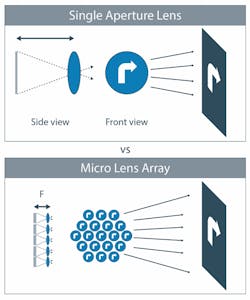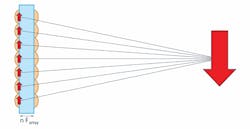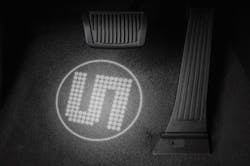How Do Micro-Lens-Array Systems Support Projected Lighting for Automotive Apps?
Key trends in the automotive industry involve producing safer vehicles for people inside and outside the car—smarter technology for more comfort and ease of use and toward cars that are “greener” or better for the environment. Lighting plays an important role in both safety and comfort. Today, the functions of automotive lighting are simple and straightforward: to illuminate the road at night; to make the vehicle visible to others; and to illuminate the cabin for the comfort and convenience of the driver and passengers at night.
With the advent of high-power LEDs, some early attempts at branding and characterization of car lighting have been made, for instance, by animating indicator (turn) lights, and by creating unique outlines for daytime running lamps (Fig. 1). In most cases, though, the basic function—illumination—remains the same as it has always been.
1. These are automotive headlamps in low beam mode. (Source: iStock.com/bizoo_n)
Now, however, new technology produced by ams is giving automotive OEMs the ability to create lighting systems for the car that do more. The new lighting systems, known as Micro Lens Array (MLA) technology, communicate and engage as much as they illuminate. For the first time, MLA technology enables car manufacturers to project a detailed, sharp image or pattern on to the road surface at a distance from the car. The array has a very small footprint and depth compared to a conventional optical projector, and can be easily integrated into the body of a car without compromising its mechanical design.
This article outlines the operational principles of MLA technology and describes the composition of a projected-lighting system. The greatest impact of the technology is likely to be on the headlamp, because of the gains made in beam quality and beam control by using micro-lens projection. There are many other potential uses for projected lighting in the car—and no doubt some still to be discovered by forward-thinking engineers.
Innovative Miniature Lens Assembly for Light Projection
In automotive lighting today, the beam is generally shaped through the use of optical technology, which is at least several decades old. In a headlamp, for example, beam control has generally been achieved by combining a large reflector and a lens embedded in the cover of the headlamp. The physics of light projection necessitates a long minimum distance between the light source and the lens. This means that the entire headlamp assembly has a large volume and occupies a substantial surface area in the body of the vehicle.
The adoption of MLA technology marks an abrupt break from traditional approaches to automotive lighting design. According to ams, it enables for the first time a tightly focused beam or even an image or pattern to be projected on the surface of the road or pavement from an assembly that’s just a few millimeters deep and high. Because of the small dimensions of an MLA-based system, projected lighting can be built into almost any part of the body of the car. Already, car manufacturers are implementing or evaluating various applications:
- Pathway lighting projected from under the door sills can display a pattern distinctive to the model or brand when the vehicle detects the proximity of the key fob (Fig. 2). This convenience and safety feature illuminates the surface where the user must step to enter the car. It also can imbue a sense of personality to the car—the lights “welcome” the driver on his or her return to the car in the dark. A unique image projected on the ground can also become a signature of the car’s brand.
- Turn signals projected onto the road from wing mirrors, providing pedestrians, cyclists, and other road users with a highly visible indication of the driver’s intention to turn, thus enhancing road safety.
- Cabin lighting embedded in the roof lining or footwells. As with pathway lighting, this enhances the convenience and comfort enjoyed by the driver and passengers, but also provides an opportunity to create an optical ambience that belongs distinctively to the brand of car.
2. A Micro Lens Array assembly projects light on to the pathway alongside the car. (Source: iStock.com/photostio)
Most dramatically, the adoption of MLA technology enables a radical rethinking of the headlamp’s design. Miniaturization is one benefit: Development projects by headlamp manufacturers supported by ams have demonstrated the feasibility of creating standards-compliant headlamps with a narrow slit profile (Fig. 3).
3. The slit headlamp concept design is based on the use of MLA technology. (Source: iStock.com/NiseriN/AD-Ventures)
The technology also offers a remarkable improvement in beam quality, uniformity, and control over both conventional headlamps and newer LED matrix headlamps. Benefits of the application of projected lighting to headlamps include key safety topics such as:
- Near elimination of the risk of dazzling oncoming vehicles.
- Vastly superior performance in rain and fog, greatly reducing the amount of light reflected from water droplets back into the eyes of the driver.
- Dynamically adaptive beam that directs light accurately where it’s needed on the road surface to provide the most useful illumination to the driver.
- The capability to project context-relevant information, such as warning signs, onto the road in front of the driver.
MLA technology, then, opens up fascinating opportunities to rethink automotive lighting design. And an MLA-based projected-lighting system owes its small size and superior optical performance to the special construction of the optical pathway in an MLA module.
The Composition of a Projected-Lighting System
An MLA-based projected-lighting assembly consists of an LED light source(s), collimator(s), and the micro-lens array itself. The array is a custom-designed module; a typical MLA measures 11.4 × 10.7 × 3.0 mm (Fig. 4).
4. These 10- × 10-mm micro-lens arrays were fabricated by ams. (Source: ams)
The array is a precisely manufactured set of miniature lenses, or “lenslets.” Because the lens array is fabricated through processes shared with the semiconductor industry, MLA technology benefits from the same cost and quality advantages enjoyed with silicon chips. Nanoscale fabrication also means that the lenslets can be precisely shaped and positioned so that they project a single, sharply focused image onto a surface at a specified distance from the projector. The surface may be specified to be flat, curved, or freeform, and perpendicular to the projector or tilted.
By projecting an image through an array of lenslets, the focal length between the light source and the lens can be hugely reduced. This creates a projector with much smaller dimensions than a conventional single-lens projector (Fig. 5).
5. A micro-lens array has a much shorter focal length than an equivalent single-lens projector. (Source: ams)
Operating Principle of the Micro Lens Array
The MLA works by projecting multiple versions of the image onto the same location on the “screen,” that is, the surface on which the image is to be viewed. In an MLA consisting of, for instance, 64 lenslets, the viewed image is actually 64 projected images overlaid on one another.
Implementing this operating principle presents considerable technical difficulties. The angle of refraction from a single light source will be slightly different for each lenslet within an array, even for projection onto a flat, perpendicular screen. The lenslets, therefore, need to be offset from one another by a minuscule amount (Figs. 6 and 7).
6. With no offset, the projected image from a lens array is blurred. (Source: ams)
7. Offsetting the image “slides” produces an exact overlay for a sharply focused image on the target plane. (Source: ams)
A specialist software tool is used by ams to calculate the optical parameters of each lenslet. Bearing in mind, however, that in a typical MLA, the lens diameter is around 0.8 mm, the focal length is around 2 mm and the lens sag is around 80 µm, it’s clear that extreme precision is required to fabricate the array’s features.
This production technology, proprietary to ams, enables the on-wafer fabrication of optical arrays using conventional semiconductor fabrication equipment. This in turn allows the optical assemblies to be manufactured economically in very high volumes.
The array of micro-lenses needs to be accurately specified and fabricated. But implementing an effective projector also calls for careful specification of the entire assembly. The light from the LED source, for instance, needs to be carefully controlled. Expert guidance from ams helps the customer correctly specify the collimator that guides light into the array. Proper collimation inhibits optical crosstalk in the lens, and thus prevents the projection of ghost images encircling the central image.
Design Considerations When Implementing an MLA Projector
When developing an automotive use case for an MLA-based projector, it’s helpful to understand how physical laws govern the size, resolution, and brightness of the image that any given array can project. For instance, there’s a tradeoff between flux and the number of resolvable points: Increasing the focal length decreases flux but increases the maximum pixel count, and vice versa. In car designs, space is at a premium, and increasing the focal length of the projector makes the entire assembly deeper and more difficult to accommodate.
That’s why MLA-based automotive applications have resolution that’s normally limited to 300 × 300 pixels (QVGA)—sufficient to project a company logo, for instance (Fig. 8).
8. The projected company logo is rendered by an MLA-based projector in a footwell. (Source: iStock.com/kenneth-cheung/ams AG)
There’s also a limit to the size of the field of illumination for any given MLA assembly and image. The field of illumination can be extended by mounting multiple MLA-based projectors in parallel in such a way that one projected image meets another at its edge. In this case, a separate slide mask must be created for each projector’s lens array, which will impact the total cost of the projector system.
Such multi-mask projector systems can be designed to create a 3D effect in which different parts of the projected pattern are in focus at different viewing distances.
Creatively Exploring MLA Tech’s Potential
Today, ams supplies MLA technology in production volumes for a pathway lighting application in premium vehicles, mostly manufactured in Europe. Automotive manufacturers, however, are currently exploring a wide range of other potential use cases for micro-projector systems.
Safety lighting is of great interest. Turn signals projected from a wing mirror, or guide lines can assist the driver when performing reversing maneuvers.
As described above, MLA technology provides scope to radically miniaturize the headlamp while greatly improving beam control and quality. The ams roadmap for projected lighting also forecasts new capabilities, to turn the headlamp into an intelligent and dynamically adaptive source of illumination. This could mean, for instance, changing the shape and range of the beam in response to changes in the vehicle’s speed and in road conditions.
In terms of comfort, convenience, and branding, there are also possibilities in projected lighting beyond today’s pathway lighting. Figure 8 shows the potential for lighting inside the cabin, which could also see micro-projectors embedded in the roof lining. On the exterior, light projection could display a virtual “button” on the road beneath the trunk, enabling the user to “press” on the light button with their foot to open the trunk.
Further in the future, carmakers envision projected-lighting technology in completely new applications, such as illuminating the exterior of autonomous vehicles. Vehicles that are autonomous to level 5 have no need for illumination to see the outside world, but they have to be seen by other road users and pedestrians. This creates scope for distinctive lighting designs that achieve the safety goal—to be seen clearly—but also form a distinctive optical outline and pattern that enhance the personality and distinctiveness of the car.
MLA technology may also enable vehicle-to-driver, vehicle-to-vehicle and vehicle-to-pedestrian communication through the projection of icons. For instance, MLA-enabled headlamps might project a crosswalk symbol on the road to signal that the driver is choosing to give way to a pedestrian who wishes to cross the road. The headlamps might also display warning signals on the road ahead of the driver when triggered by the vehicle’s traffic and safety information system.
These practical use cases for MLA technology in the vehicle provide for novel applications of lighting; not just for illumination, but also for communication as well as branding and personalization. But while the applications are unfamiliar, the optical technology itself is already proven. The ability of ams to mass-produce wafer-level optics and deliver fully packaged assemblies is proven in consumer devices and, in the case of micro-lens arrays, in the automotive sector.
Sinisa Dohnal is Product Manager of Projected Lighting Solutions at ams.









